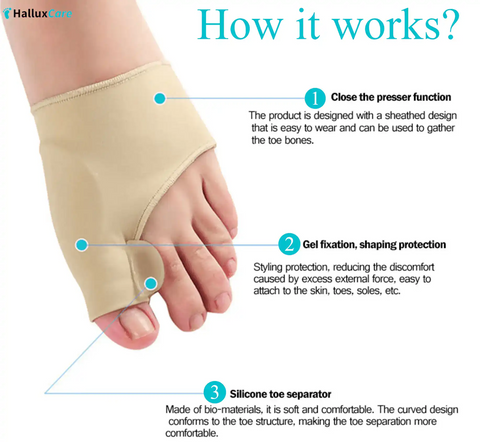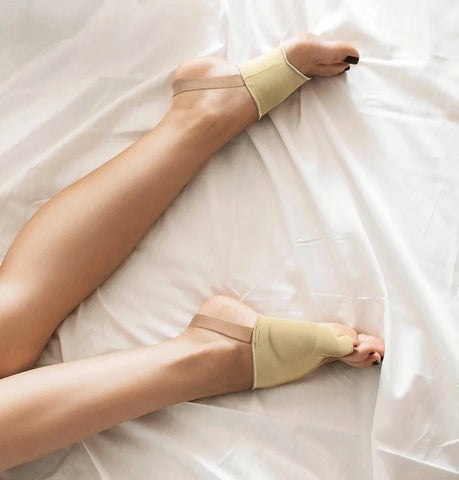Running with Bunions: Can You Stay Active Without Making Them Worse?
🕒 Last Updated: April 2025
✍️ Written by: Dr. Kelly Munroe, DPM – Board-Certified Podiatric Physician
🔍 Medically Reviewed by: Dr. Rachel Wei, MD – Sports Medicine Specialist
If you're a runner dealing with bunions, you're not alone. Bunions—medically known as hallux valgus—are a common foot deformity that can develop gradually and worsen over time. According to the American Orthopaedic Foot & Ankle Society (AOFAS), bunions affect up to 23% of adults aged 18–65, and higher rates are found in those who are physically active or wear ill-fitting shoes.
One Reddit user recently shared their concern about running with a bunion that isn’t painful yet—but they’re worried about the long-term impact. If that sounds like you, this article is here to help. We’ll explore how runners can stay active without making their bunions worse, including expert-backed treatments and product strategies.
---
Key Takeaways
- ✅ Yes, you can run with bunions—but it requires supportive footwear and careful monitoring.
- 🦶 Toe spacers, sleeves, and orthotics can reduce pain and slow progression.
- 🧘♀️ Foot exercises, anti-inflammatory strategies, and lifestyle adjustments are essential.
- 🛑 Surgery is often a last resort; conservative care is effective for many runners.
---
Understanding Bunions: Why Runners Should Pay Attention
Bunions are not just cosmetic. They result from a structural misalignment of the first metatarsophalangeal joint (the joint at the base of the big toe). Over time, the big toe drifts inward toward the second toe, causing a visible bump on the side of the foot.
What Causes Bunions?
- Genetics (hereditary foot structure)
- Biomechanical imbalances (flat feet, overpronation)
- Tight, narrow, or high-heeled footwear
- Repetitive stress from activities like running
“Bunions are a progressive condition—meaning they tend to get worse without intervention,” says Dr. Casey Ann Pidich, DPM, a podiatrist at City Podiatry in NYC.
---
Can You Run with Bunions?
Yes, many runners with bunions continue to train and compete. But ignoring the signs of progression—such as pain, swelling, or increased deformity—can lead to long-term issues like joint arthritis or nerve compression.
Tips for Maintaining an Active Lifestyle with Bunions:
- 👟 Choose Proper Footwear: Look for shoes with wide toe boxes, zero-drop soles, and adequate cushioning. Brands like Altra, Topo Athletic, and Hoka often perform well for bunion sufferers.
- 🦶 Use Orthotic Inserts: Custom or over-the-counter orthotics help redistribute pressure and support your arches.
- 🧘 Practice Foot Mobility Exercises: Daily stretching and strengthening—especially of the toe flexors and calf muscles—can improve foot mechanics.
- 🧊 Don’t Ignore Pain: Use ice, NSAIDs, or topical therapies at the first sign of inflammation.
---
Toe Spacers: Do They Actually Help?
Toe spacers are simple silicone or foam devices worn between the toes to restore natural alignment.
Pros:
- ✔️ Temporarily realign the toes during rest or light movement
- ✔️ Reduce skin friction and bunion irritation
- ✔️ Stretch tight ligaments and soft tissue
Cons:
- ❌ Not a permanent fix—alignment returns once removed
- ❌ May feel awkward or bulky inside running shoes
- ❌ Results vary widely based on severity and foot shape
“I recommend using toe spacers during recovery periods, yoga, or while relaxing at home—not during high-impact activities,” says Dr. Emily Splichal, DPM, a functional podiatrist and movement specialist.
---
Holistic Approaches to Bunion Pain Relief
Managing bunions isn’t just about the right footwear—it’s a whole-body approach.
Lifestyle Adjustments That Support Foot Health:
- 🧘 Daily Toe and Ankle Mobility
Try toe curls, marble pickups, and ankle circles to improve joint function. - 🍃 Anti-inflammatory Diet
Foods rich in omega-3s (salmon, flax seeds), turmeric, and dark leafy greens may help reduce joint inflammation. - 🌿 Topical Oils and Massage
Oils like castor oil or arnica can soothe irritated skin and joints. Massage improves circulation and reduces tension around the bunion. - 🩰 Footwear Rotation
Avoid wearing the same shoes every day. Rotate between supportive sneakers and minimalist options to engage various foot muscles.
---
Avoiding Surgery: Is It Possible?
Surgery is typically recommended only when conservative methods fail or when pain severely limits mobility.
Non-Surgical Options That Work:
- ✅ Medical-grade toe spacers and correction sleeves
- ✅ Manual therapy from a physical therapist or podiatrist
- ✅ Foot strengthening exercises like toe yoga
- ✅ Activity modification to reduce joint stress
According to the American College of Foot and Ankle Surgeons (ACFAS), “early conservative treatment of bunions can significantly delay or even eliminate the need for surgery.”
---
Final Thoughts: Keep Running, But Be Smart
Bunions don’t have to stop you from running—but they do require attention. The key is to be proactive rather than reactive. Listen to your body, invest in the right tools, and consider support from podiatric professionals when needed.
Whether you're stretching post-run or exploring gentle correction products, small daily habits can make a big difference in your long-term joint health.
---
Recommended Bunion Relief Products from HalluxCare
If you're looking for relief from bunion pain, consider using the Orthopedic Bunion Pain Relief & Correction Sleeve, which provides support and helps to alleviate discomfort.
4.9 ⭐⭐⭐⭐⭐ (1843 reviews)
For additional protection, the Tailor's Bunion Bunionette Pain Relief Protection Sleeves are designed to offer comfort and protection for bunionette pain.
To nourish and soothe the skin around bunions, as well as to promote healthy hair, consider the Jamaica Black Castor Oil Soothing Oil. Known for its moisturizing and anti-inflammatory properties, it helps alleviate discomfort around bunions and supports hair growth and scalp health.
---
Practical Tips for Everyday Runners with Bunions
- Schedule a gait analysis with a podiatrist or physical therapist
- Keep running surfaces as soft as possible (grass, tracks, treadmills)
- Use toe spreaders during cool-downs or while watching TV
- Log symptoms daily to track flare-ups and improvements
---
Frequently Asked Questions (FAQs)
Q: Can running worsen my bunions?
A: Yes, high-impact activity like running can exacerbate bunions if not managed with proper footwear and support. However, many runners continue training with minimal issues by taking preventive steps.
Q: Are toe spacers effective long-term?
A: They can provide temporary relief and improve alignment, but they are not a permanent fix. Use them in combination with strengthening exercises and footwear changes.
Q: When should I consider seeing a podiatrist?
A: If your bunion causes persistent pain, affects your gait, or begins interfering with daily activities, it’s time to consult a specialist.
Q: Do bunion sleeves work while running?
A: Some runners find bunion sleeves helpful during runs for reducing friction and pain. Look for sleeves that are lightweight, breathable, and designed for movement.
---
📣 We Want to Hear from You!
Are you running with bunions? Have toe spacers or sleeves helped your comfort or performance? Share your experience in the comments below—we’d love to learn from the community!
---
📚 Sources:
- American Orthopaedic Foot & Ankle Society (AOFAS)
- American College of Foot and Ankle Surgeons (ACFAS)
- Dr. Casey Ann Pidich, DPM, City Podiatry
- Dr. Emily Splichal, DPM, Evidence Based Fitness Academy
✨ Stay active, stay informed, and take care of your feet!




